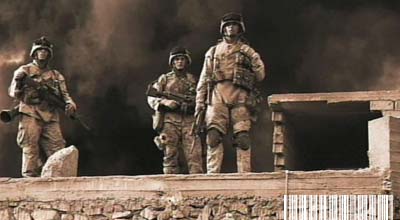
On Dec. 19, 2006, President George W. Bush said for the first time that the United States is not winning the war in Iraq. It was a dramatic admission from a president who had insisted since the start of the war that things were under control.
Now, as the U.S. begins what the administration hopes is the final effort to secure victory through a "surge" of troops, Gen. Jack Keane (Ret.), Col. William Hix, Col. H.R. McMaster, Maj. Thomas Mowle, State Department Counselor Philip Zelikow and other military and government officials talk to FRONTLINE about both the military and political events that have led up to the current "surge" strategy. Endgame is the fifth film in a series of Iraq war stories from FRONTLINE producer Michael Kirk, including Rumsfeld's War, The Torture Question, The Dark Side and The Lost Year in Iraq.
When the United States initially invaded Iraq, the plan was to withdraw within three months, so there was no long-term strategy for battling a growing insurgency that would soon destabilize the country. In a surprising public admission, Gen. Jack Keane, the Army's second in command at that time, tells FRONTLINE, "I think it's driven in part by my own failures when I was there as a senior military leader contributing to Gen. [Tommy] Franks' plan -- that we never even considered an insurgency as a reasonable option."
In 2004, responding to the the Abu Ghraib prison scandal, American withdrawal from Fallujah, and worsening violence, Secretary of Defense Donald Rumsfeld dispatched four-star Gen. George Casey to Iraq to take control of the situation. Both Casey and Rumsfeld believed that maintaining a "light footprint" -- minimizing the role of the American forces while building up the Iraqi security forces -- would ensure security for the upcoming elections.
When Iraqis went to the polls in January 2005, the administration pointed to the election as a sign of success. But with an almost complete Sunni boycott of the election, the resulting government had, as one officer described it to FRONTLINE, "tenuous legitimacy."
In many ways it was the definitive moment in the Iraq war. "The die was cast once the Sunni Arabs did not participate in the elections. Everything that has followed … has been a logical consequence," Casey strategist Maj. Thomas Mowle tells FRONTLINE.
Sectarian violence in Iraq was growing and came to a head in February 2006, when Sunni insurgents bombed the golden dome of the Askariya shrine in Samarra. "The Shi'a [began] to fight back with the Sunni," author Lawrence Kaplan tells FRONTLINE. "And what was one-sided insurgency [became] a two-sided civil war."
As Rumsfeld and Casey continued to insist that things were going well, Secretary of State Condoleezza Rice sent State Department Counselor Philip Zelikow to Iraq to assess the situation. Col. H.R. McMaster's "clear, hold and build" effort conducted in Tal Afar was one of the rare successful operations Zelikow could find. After U.S. troops cleared insurgents from the city by going door to door, a sustained troop presence in each neighborhood helped the residents feel secure, allowing the rebuilding by U.S. troops to begin. "What is amazing is how once you are able to lift the pall of fear off these people, how life just flows back into these cities," McMaster says. "But what's important is to keep security there."
Rice went to the Senate Foreign Relations Committee to report on and advocate for the "clear, hold and build" strategy, but Rumsfeld publicly criticized the strategy and held fast to the "light footprint" plan, in which Iraqi forces are depended upon to perform the "hold and build" portions of the endeavor.
In summer 2006, Casey mounted Operation Together Forward II, relying heavily on Iraqi troops to maintain security in the areas of Baghdad that American troops had cleared. Keane tells FRONTLINE: "We had made up our minds that we were going to clear, but we didn't have the resources to hold. As soon as I saw that we didn't have the resources, I knew that the operation would fail. … Our chances to succeed in Iraq were slipping past us. We needed to change the strategy, or else this thing was going to go off the cliff."
Following what President Bush called a Republican "thumpin'" in the November 2006 midterm U.S. elections, the president replaced Donald Rumsfeld with Robert M. Gates. The White House publicly launched a review of the Iraq strategy and ultimately called in Gen. Keane, who proposed "clear, hold, build" operations in Baghdad with a "surge" of new troops.
But for the military's strategists, the nagging question is whether it is already too late.
home . introduction . watch online . interviews . timeline . themes . join the discussion
producer's chat . readings & links . site map . dvd & transcript . press reaction
credits . privacy policy . journalistic guidelines . FRONTLINE series home . wgbh . pbs
posted june 19, 2007
FRONTLINE is a registered trademark of wgbh educational foundation.
main photograph © corbis, all rights reserved
web site copyright WGBH educational foundation
![Endgame [home page]](../art/p_title.gif)
